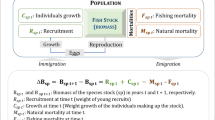Abstract
A study was conducted to examine the long-term relationship among price of fish, harvest level, and resource condition using a bioeconomics model. Data on the annual amount of production and prices of octopus (Octopus vulgaris) in Morocco from 1970 to 2006 are plotted on a diagram to trace annual changes of price and production. The plotted pattern suggests a long-term movement of the yield-price equilibrium along the line of a theoretical long-term supply function curve of the bioeconomics model. The plotted data also suggests that there are four stages of resource exploitation for octopus in Morocco: (1) the underexploited stage from 1970 to 1987 which is characterized by small catch and low prices, (2) the maximum sustainable yield (MSY) stage from 1988 to 1998 which is characterized by moderate catch and intermediate prices, (3) the overexploited stage from 1999 to 2001 which is characterized by large catch and intermediate prices, and (4) the reduced stock stage after 2002 which is characterized by small catch and high prices. This result is consistent with the independent scientific research information on octopus harvested in Morocco. Our study indicates that an analysis of market information (i.e., amount of production and price) could be an effective tool in identifying approximate status of fishery resources.



Similar content being viewed by others
References
OECD (2003) Liberalizing fisheries markets: scope and effects. OECD, Paris
FAO (2007) The state of world fisheries and aquaculture 2006. FAO, Rome
El Filali H, El Ayoubi H (2004) Marine fishery sector in morocco and tax reform for growth promotion and sustainable management. FAO Fisheries Report No. 732, FAO, Rome
Clark CW (1976) Mathematical bioeconomics: the optimal management of renewable resources. Wiley, New York
Ariji M (2004) The economical analysis of the Japanese fisheries’ sustainability. Taga, Tokyo (available only in Japanese)
FAO (2006) Report of the FAO/CECAF working group on the assessment of demersal resources—subgroup North. Saly, Senegal, 14–23 September 2004, CECAF/ECAF Series 06/68. FAO, Rome
Acknowledgments
The authors would like to express their sincere gratitude to Dr. Abdellatif Berraho and Dr. Salah Bencherifi of INRH, Morocco, for their kind help and advice, and also to thank Mr. Abdelouahed Benabbou, Head of Cooperation and Legal Affairs, and Mr. Youssef Ouati, Chef Cooperation Division, Ministry of Fishery and Maritimes, Morocco, for their encouragement of this study.
Author information
Authors and Affiliations
Corresponding author
Rights and permissions
About this article
Cite this article
Yagi, N., Ariji, M., Takahara, A. et al. Application of a bioeconomics model to examine sustainability of fishery resources in the global market: the case of octopus resource in Morocco. Fish Sci 75, 43–46 (2009). https://doi.org/10.1007/s12562-008-0023-7
Received:
Accepted:
Published:
Issue Date:
DOI: https://doi.org/10.1007/s12562-008-0023-7




